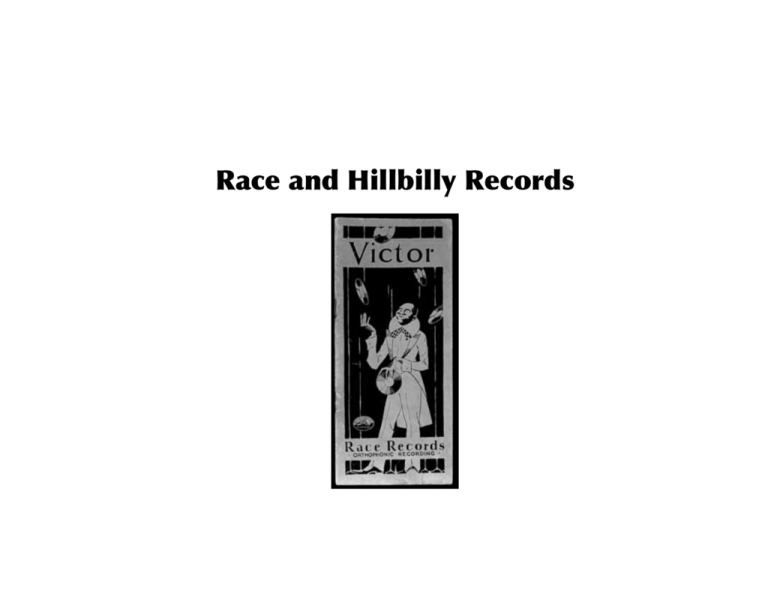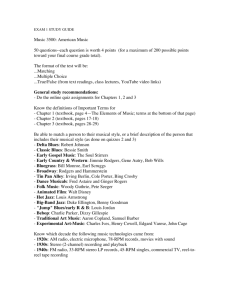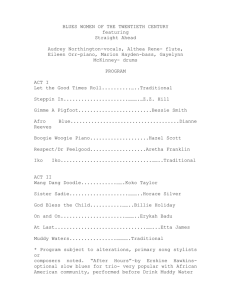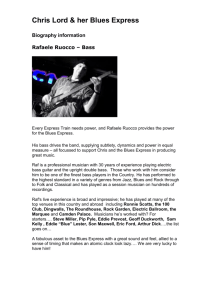Race and Hillbilly Records
advertisement

Race and Hillbilly Records Early Phonographs Early radio • 1st commercial radio broadcast in 1920 • 1922: 600 stations • “Free” entertainment competed with record industry • Radio impacted pop song: – Artistic blandness and conformity to please sponsors – Generated huge celebrities – Sped up “life” of pop hits – Popularized regional styles and artists Independent Labels: Black Swan and OKeh Records • Black Swan: – African American-owned company in Harlem (1920s) – Owner Harry Pace wanted to create music for and by African Americans – Attempted to show breadth of African American taste – Released “hot” jazz, blues, gospel and classical music by black artists • Recognized “new” market: African American record buyers – Urban migration in 1917 – Rural popularity of phonograph – Connected African American communities OKeh Records pioneered another approach to Race Records • Term “Race Records” coined by OKeh exec. Ralph Peer • • • • Exploited and promoted a distinctive African American identity based on musical taste and racial stereotypes Recorded music outside of commercial mainstream: blues, hot jazz, gospel Competed with Tin Pan Alley establishment Popularized musical form called Blues Who first thought of getting Race Records out for the Race? Okeh, that's right! Genuine Race Artists make genuine Blues for Okeh. There is also a complete alphabetical index, listing every Race Record you might crave. Do go on and turn our pages and see the kind of stuff we're holding back. Every smilin', teasin' brownskin gal in dis book of Greatest Blues has jes got it natchely, the dawggone Blues; dis ain't no time to git blues, jes go back downtown and git some of our Okeh Blues, then there's nuthin' gonna stop you from feelin' as happy as a kissin' papa. Boy, do that thing--and tell 'em about Okeh.” The Classic Blues • Blues refers to a form of Southern folk music originally developed in black Southern communities • “Professionalized” in the style of classic blues: – Performed by female nightclub and vaudeville singers – Professionally composed, accompanied by jazz bands – Heavily promoted through race records • Features distinct form – 12-Bar Blues: • Refers to a particular arrangement of a verse into 4-beat bars with… • 3 phrases, each containing 4 bars • A sequence of 3 chords (chord progression) • A distinct poetic structure: AAB Listening Example: “St. Louis Blues” Composed by W.C. Handy Performed by Bessie Smith, 1925 • ARRANGEMENT – – – Accompanied by a jazz combo, including Louis Armstrong on cornet (call and response w/vocals) Vocal quality is rough and full throttle -Vaudeville style “classic blues” FORM:composer W.C. Handy combined 12-bar blues with Tin Pan Alley pop structure Melody A Melody A 12-bar blues (AAB lyric structure) repeated Melody B 16-bar bridge (8-bar melody sung twice) Melody C 12-bar blues new melody! new lyrics structure! ABC Country Blues • Rural-based folk style of blues music – Expressed the experiences of impoverished Southern black work force: sharecroppers, rivermen, railroad workers, prisoners – Spread by guitar-players/singers who sang about their own experiences/stories • Less formalized than classic blues: – Oral tradition – 12-bar form is flexible – Sometimes riffs replace chords • Blues lyrics themes: – Realistic, personalized view of everyday life: relationships, politics, money – Hidden meanings, use of metaphor – Humor, irony, wit as antidote to oppression • • Ex: – Charley Patten, “Tom Rushen Blues” (1929) – Blind Lemon Jefferson, “Black Snake Moan” (1927) OKeh Records and country music • Ralph Peer coined “hillbilly” genre in 1923 – Recorded old-time fiddler John Carson in Georgia • Huge sales - unexpected! • Spurred interest in recording rural Southern white artists • Promoted gospel, blues, string bands, jug bands • Promoted two kinds of imagery: – Home/Family/Faith – Uprooted/Hard Luck Blues Jimmie Rodgers and The Carter Family • Both Rodgers and the Carters “discovered” by Ralph Peer in Bristol, TN in 1927 • The Carters emulated a conservative, religious, and family-based image – Sang old ballads and gospel songs Rodgers, in white suit, posing with the Carter Family • Rodgers was a wandering railroad man who sang about hobos and hard luck – Sang white blues and ballads The Carter Family: A.P. “Doc” Carter (bass vocals) Sara Carter (lead vocals, autoharp) Maybelle Carter (guitar) Natives of the Clinch Mountains, Virginia Style/Stance: Straightforward, unembellished “authentic” white gospel and mountain music Humility and devotion to church and family, traditional values Conveyed through “plain” arrangements and conservative image • Jimmie Rodgers: – From Meridian, MS – Worked on railroads – Influenced by white and black “folk” music (ballads, country blues) – Adapted style to popular music (“Waiting For a Train”) – 1933 - Died of tuberculosis at 36 • Style/Stance: – Wrote and performed his own songs about American underbelly, hard luck folks – Images of urban migration, lost home/family – Used blues to convey a sense of loss – Described conflict between establishment and those outside of it







